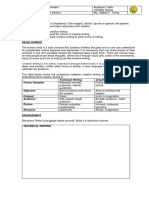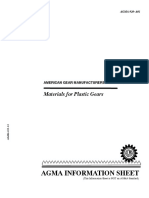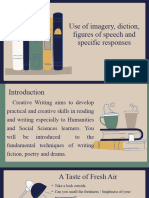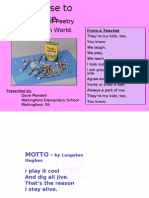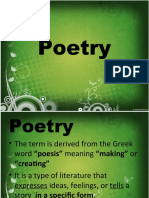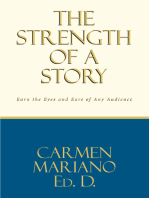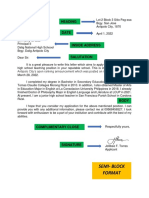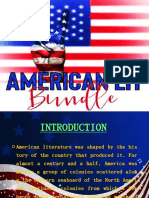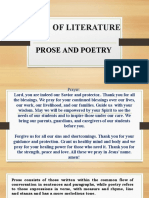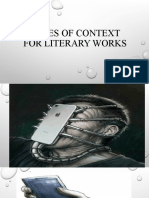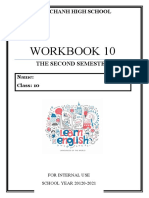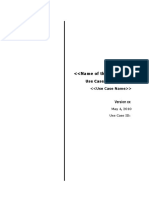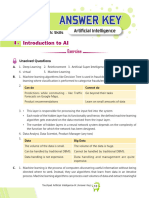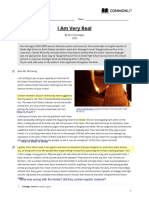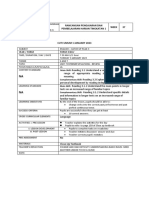Authors Style and Purpose
Uploaded by
JOLLIBEE TORRESAuthors Style and Purpose
Uploaded by
JOLLIBEE TORRESAuthor’s
Style
What is STYLE ?
• Every author has his or her own style –
that is, each author uses literary devices,
tone, and mood in a particular way that
makes his or her writing recognizable.
• When you read several books by the
same author, you become accustomed to
the author’s style of writing and
sometimes you look for authors with a
similar style.
Author’s Style
• Author’s style is the way he or she uses words
to make ideas come alive on the page.
• Author’s Style Techniques:
Word Choice
Dialogue
Tone
Mood
Sensory Language
Author’s Style – Word Choice
• Author can use formal or informal words
• Informal: Jason’s friends dissed him.
• Formal: Jason’s friends ignored him.
Author’s Style
Formal vs. Informal
Formal:
Dear Sir,
After examining your job description, I feel I am an excellent
candidate. I have many years of experience performing these specific duties.
My résumé is attached. Please read it over at your convenience and contact
me if you have questions.
Sincerely,
Andrew Meyer
Informal:
Hey, Sara! What's going on tonight? Call me before you guys leave,
okay?
--Beth
Author’s Style –
Sentence Length
• Sentence lengths can vary.
• Janice went to the store. She bought a scarf.
• Janice went to the department store, where
she bought a woolen scarf.
Author’s Style – Dialogue
• Shows the reader how characters
speak and can show the character’s
background.
• “I flipped right outta the wagon
after he jammed his foot on the
brakes.”
• “I am confident the hours he spent
sailing the yacht enabled him to
pass the exam.”
Author’s Style – Tone
• Tone tells what the author’s attitude toward
the subject is.
• Formal language creates a serious tone.
• Informal language creates a light-hearted
tone.
• Tarantulas lurk in hidden places in the desert.
• Beware of creepy crawlers in the desert.
• Setting can help create tone.
Tone Example
The girls were playing in the pond, splashing each other
and trying to catch fish with their hands. They were having fun,
but kept looking over their shoulders at the looming forest. The
long grass of the field kept moving and they sort of felt like they
were being watched… About a half hour passed and still the
girls kept checking the field for movements. It seemed like a pair
of dark eyes was on them. They even considered going back
inside, but that would mean homework time. So they continued
splashing, but with caution now. Their eyes hardly left the field.
The tone of this passage is threatening, suggesting a little bit of
fear or dark. Words like "caution, dark, and looming“ lead
readers to the tone.
TONE EXAMPLE
Finally, one of the girls pointed to the grass and giggled.
"Meow!" A cat sat on the edge of the field and licked
its paw. They did indeed have company. The girls ran
over to the cat and pet his belly. They laughed and the
cat sauntered contently back to the field.
The tone of this passage is happy/contentment as there
was a successful, happy resolution to the problem.
Also, words like giggled and laughed give us clues
about the tone.
Author’s Style – Mood
• Mood is the atmosphere or feeling that the
author creates in the story.
• Maria wore a black veil to cover her tears.
• The child giggled as she danced around.
MOOD EXAMPLE
During the holidays, my mother's house glittered with
decorations and hummed with preparations. We ate
cookies and drank cider while we helped her wrap
bright packages and trim the tree. We felt warm and
excited, listening to Christmas carols and even singing
along sometimes. We would tease each other about
our terrible voices and then sing even louder.
Mood: Content, happy. How do we know? Words like
"warm, excited, glittered” are used by the author.
MOOD EXAMPLE
After New Year's the time came to put all the
decorations away and settle in for the long, cold
winter. The house seemed to sigh as we boxed up its
finery. The tree was dry and brittle, and now waited
forlornly by the side of the road to be picked up.
Mood: Dreary, depressed. How do we know? "cold, sigh,
brittle, forlornly"
Author’s Style –
Sensory Language
• Sensory Language appeals to the
five senses and creates a certain
style.
• The breeze tossed her golden
curls around her head, while the
fragrant blossoms entwined in
her hair quivered and bounced.
Author’s Style –
Sensory Language
• Sight words – words that make the reader see what the author sees.
i.e. colors, movements, shapes, appearance
• Sound words – words that make the reader hear what the author
hears. i.e. piercing, rowdy, racket, whisper, mutter, laugh, scream,
cry
• Taste words – words that make the reader taste what the author
tastes. i.e. bitter, tangy, hot, sweet
• Smell words – words that make the reader smell what the author
smells. i.e. fresh, moldy, decomposing, sweet
• Touch words – words that make the reader feel what the author
feels. i.e. damp, cold, fuzzy, sharp, smooth, sticky
Examples
• Sight: orange glare, green willows, wilted
and dry willows, brown bank
• Smell: sweaty clothes, the pungent skin,
dusty odor of the earth
• Touch/Feel: cool water, hot July sun,
cool green willows, sun-baked backs,
dusty bank, the sharp briers pulling,
damp jeans
Examples
• Taste: a strawberry ice, a tall
frosted glass of lemonade, deep
pink sweetness of the
watermelon
• Sound: crackling underbrush, the
melon gave way with a crack
Where the Red Fern Grows
(Wilson Rawls)
• p 42, “The leader of the gang was about
my size. He had a dirty freckled face and
his two front teeth were missing. I
suppose he had lost them in a back alley
fight. His shock of yellow sun burnt hair
bobbed up and down as he skipped and
jumped to the rhythm of the ‘dog boy’
song.”
Examples:
Where the Red Fern Grows
• p 10, “Below our field, twisting and
winding, ran the cool blue waters of
the river. The banks were cool and
shady. The rich bottom land near
the river was studded with tall
sycamores, birches, and box elders.”
Examples:
Where the Red Fern Grows
• p 21, “A silent gray shadow
drifted down from the top of a
tall sycamore. There was a
squeal and a beating of wings. I
heard the tinkle of a bell in the
distance ahead.”
Examples:
Where the Red Fern Grows
• p 32, “I took one look at my
bare feet and winced. They
were as brown as dead
sycamore leaves. The spider-
web pattern of raw, red
scratches looked odd in the
saddle brown skin.”
DICTION IS THE CHOICE AND USE OF WORDS IN
SPEECH AND WRITING .
Denotation and Connotation:
Denotation is the dictionary definition of a word:
Connotation refers to the response a word really
arouses in the reader or listener.
Mother denotatively means “female parent” but
means much more connotatively.
The visual image has connotations,
too:
• What do these images of mothers suggest?
What do these images of mothers
suggest?
On His Blindness (John Milton)
• When I consider how my light is spent
• Ere half my days in this dark world and wide,
• And that one talent, which is death to hide,
• Lodged with me useless, though my soul more
bent
• To serve therewith my Maker and present
• My true account, lest He returning chide;
• “Doth God exact day-labor, light denied?”
• I fondly ask, but patience, to prevent
• That murmur, soon replied: “God doth not need
• Either man’s work or His own gifts: who best
• Bear His mild yoke, they serve Him best; His state
• Is kingly; thousands at His bidding speed,
• And post o’er land and ocean without rest
• They also serve who only stand and wait.”
Comprehension Response
• 1. What does light refer to in the first line of
the poem?
• 2. What does Milton mean by his “one talent’?
• 3. What does he mean by “my true account”?
• 4. What does “light denied” refer to?
• 5. What is the main idea expressed in the
poem?
• In what different ways we can serve God?
Style
• There may be as many styles
as there are writers. Think
about your favorite authors?
Why do you like their books?
Is it because of their style of
writing? . . . And if so, how
would you describe their style
of writing?
You might also like
- Formulating Claims of Fact, Value and Policy100% (1)Formulating Claims of Fact, Value and Policy1 page
- Activity Sheet - Week 1 Creative WritingNo ratings yetActivity Sheet - Week 1 Creative Writing9 pages
- AGMA 920-A01 - Materials For Plastic Gears100% (1)AGMA 920-A01 - Materials For Plastic Gears46 pages
- Author' S Style: Wash Publishing Co. 2009No ratings yetAuthor' S Style: Wash Publishing Co. 200917 pages
- Describe with 5 senses and descriptive wordsNo ratings yetDescribe with 5 senses and descriptive words37 pages
- The Power of Poetry in A High-Tech WorldNo ratings yetThe Power of Poetry in A High-Tech World27 pages
- Tone and Mood - Power Point - 25 SlidesNo ratings yetTone and Mood - Power Point - 25 Slides25 pages
- Imageryfiguresofspeechanddiction 221002103216 2b0d7473No ratings yetImageryfiguresofspeechanddiction 221002103216 2b0d747337 pages
- The Strength of a Story: Earn the eyes and ears of any audienceFrom EverandThe Strength of a Story: Earn the eyes and ears of any audienceNo ratings yet
- Stage Ready Tales for Creative Youth: Inspiring Youth with Couplets - Vol. 1From EverandStage Ready Tales for Creative Youth: Inspiring Youth with Couplets - Vol. 1No ratings yet
- Creative Writing Activity Sheet Drama 2No ratings yetCreative Writing Activity Sheet Drama 210 pages
- BSBTWK502 Project Portfolio Student - Template.v1.0No ratings yetBSBTWK502 Project Portfolio Student - Template.v1.08 pages
- Certificate of Recognition For CommitteesNo ratings yetCertificate of Recognition For Committees40 pages
- Canticle of the Sun - Marty Haugen (Music Sheet)No ratings yetCanticle of the Sun - Marty Haugen (Music Sheet)3 pages
- Class XI Unsolved Question&Answers (Part B-Unit-1 To 4)No ratings yetClass XI Unsolved Question&Answers (Part B-Unit-1 To 4)13 pages
- ICWAI Paper 1 Fundamentals of Economics and Management100% (2)ICWAI Paper 1 Fundamentals of Economics and Management416 pages
- Module 11: Partial Derivatives, Chain Rules, Implicit Differentiation, Gradient, Directional Derivatives Lecture 31: Partial Derivatives (Section 31.1) ObjectivesNo ratings yetModule 11: Partial Derivatives, Chain Rules, Implicit Differentiation, Gradient, Directional Derivatives Lecture 31: Partial Derivatives (Section 31.1) Objectives9 pages
- Signals and Systems Analysis course outlineNo ratings yetSignals and Systems Analysis course outline3 pages
- Imageryfiguresofspeechanddiction 221002103216 2b0d7473Imageryfiguresofspeechanddiction 221002103216 2b0d7473
- The Strength of a Story: Earn the eyes and ears of any audienceFrom EverandThe Strength of a Story: Earn the eyes and ears of any audience
- Writing and Being: Embracing Your Life Through Creative JournalingFrom EverandWriting and Being: Embracing Your Life Through Creative Journaling
- Stage Ready Tales for Creative Youth: Inspiring Youth with Couplets - Vol. 1From EverandStage Ready Tales for Creative Youth: Inspiring Youth with Couplets - Vol. 1
- BSBTWK502 Project Portfolio Student - Template.v1.0BSBTWK502 Project Portfolio Student - Template.v1.0
- Class XI Unsolved Question&Answers (Part B-Unit-1 To 4)Class XI Unsolved Question&Answers (Part B-Unit-1 To 4)
- ICWAI Paper 1 Fundamentals of Economics and ManagementICWAI Paper 1 Fundamentals of Economics and Management
- Module 11: Partial Derivatives, Chain Rules, Implicit Differentiation, Gradient, Directional Derivatives Lecture 31: Partial Derivatives (Section 31.1) ObjectivesModule 11: Partial Derivatives, Chain Rules, Implicit Differentiation, Gradient, Directional Derivatives Lecture 31: Partial Derivatives (Section 31.1) Objectives



